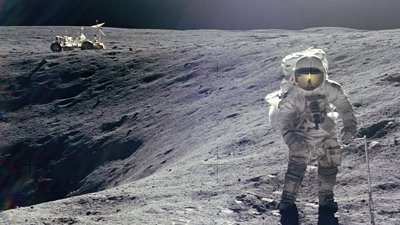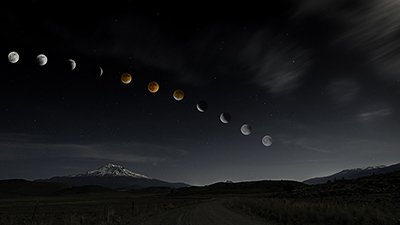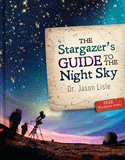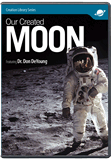Comeback of Giant Impact Hypothesis
“Giant impact hypothesis” makes a comeback.
News Source
- Smithsonian blog: “How the Moon Was Made”
Shining down night after night, defying a series of evolutionary hypotheses to explain its origin, is the moon. Evolutionary astronomers have suggested many possibilities over the years, but each has significant problems, such as geochemical discrepancies or failure to measure up in computer simulations. Of course, in a determined effort to come up with a naturalistic explanation for the satellite that reflects sunlight into our night sky, the starting conditions in simulations (which conveniently cannot be verified) can be adjusted until a mathematical model finally works. Geochemical analyses—actual laboratory measurements of moon rocks, for instance—would seem harder to fudge, but alas even those results must be interpreted.
The giant impact hypothesis, originally proposed in the 1970s, like other moon origin ideas, has had its share of problems. The giant impact story holds that, about 30 million years after our solar system began to form, a Mars-sized proto-planet (Theia) collided with earth. As a result of the explosion, Theia’s heavy elements (like iron) sunk into earth’s core while the lighter elements of both earth and Theia vaporized and spewed out into space. Some of the debris then presumably coalesced to form the moon.
While the giant impact notion seemed to explain the moon’s apparently small iron core, other serious problems remain.
While the giant impact notion seemed to explain the moon’s apparently small iron core, other serious problems remain—such as the dynamics of spewing enough material into space to build a moon, having those pieces actually stick together, establishing a stable orbit, and disposing of excessive angular momentum. Despite these problems, for many the “giant impact” has remained the default choice because it seemed to have fewer difficulties than other proposals.1
Geochemists now report they have the first definitive physical evidence in support of the giant impact hypothesis. A team analyzed zinc isotopes present in lunar rocks from 20 different locations. They compared the results with analyses of earth rocks and meteorites thought to be from Mars. The moon rocks have a higher percentage of the heavier zinc isotopes than earth rocks and these meteorites.
When rock is vaporized, the lighter isotopes (at least those of moderately volatile elements, like zinc) tend to be vaporized first. Therefore, if earth was really struck by Theia and the vapor vented into the vacuum of space, the remaining debris should theoretically have a higher proportion of heavier isotopes remaining. If that debris clumped together to make the moon, then moon rocks should all have a higher proportion of heavier zinc isotopes than earth and Martian rock.
“When a rock is melted and then evaporated, the light isotopes enter the vapor phase faster than the heavy isotopes,” explains Washington University professor Frédéric Moynier, who led the study. “You end up with a vapor enriched in the light isotopes and a solid residue enriched in the heavier isotopes. If you lose the vapor, the residue will be enriched in the heavy isotopes compared to the starting material.”
Since all of the “lunar magmatic rocks are enriched in the heavy isotopes of zinc and have lower zinc concentrations than terrestrial or Martian igneous rocks,”2 the geochemists believe that isotopic ratio was established by a primordial vaporization event that affected the entire moon, not by isolated volcanic eruptions.
While the authors of the paper published in Nature consider their results to be “compelling evidence for evaporative loss of volatile elements during lunar formation,”3 we need to see how this sort of “evidence” compares to that of investigations closer to home. In the course of investigating a crime, forensic scientists may discover evidence consistent with many possible scenarios, but they ultimately seek for witnesses to validate what really happened. Building a convincing story without corroborating witnesses is a good way to convict the innocent.
Analogously, finding an isotopic ratio that fits a desired story for the moon’s origins does not make that story true. Even beyond the other problems with the giant impact hypothesis, the greatest problem remains: its lack of a corroborating witness. In fact, the only eyewitness account attesting to the origin of the moon is provided by God in Genesis 1:14–19.4
The biblical idea, that God created the moon ex nihilo (from nothing) about 6,000 years ago along with the rest of our solar system and the stars, does not seek to “explain” why the moon has a different proportion of zinc isotopes, but it does not have to. Any models describing the history of the solar system must be consistent with this historical fact revealed in the Bible to have the possibility of being valid. Evolutionary astronomers, by ignoring the biblical account, ignore their one completely reliable Eyewitness.
Further Reading
- Our Scarred Moon
- Origin of the Solar System
- Sun and Planets Built Differently Says Nasa
- Source of Earth’s Water
- Comets Had a Role In Forming Earth’s Oceans, Study Shows
- Does the Big Bang Fit with the Bible?
For More Information: Get Answers
Remember, if you see a news story that might merit some attention, let us know about it! (Note: if the story originates from the Associated Press, FOX News, MSNBC, the New York Times, or another major national media outlet, we will most likely have already heard about it.) And thanks to all of our readers who have submitted great news tips to us. If you didn’t catch all the latest News to Know, why not take a look to see what you’ve missed?
(Please note that links will take you directly to the source. Answers in Genesis is not responsible for content on the websites to which we refer. For more information, please see our Privacy Policy.)
Footnotes
- “This [giant impact hypothesis] has arisen not so much because of the merits of [its] theory as because of the apparent dynamical or geochemical short-comings of other theories,” according to A. Ruzicka, G. A. Snyder, and L. A. Taylor, “Giant Impact and Fission Hypotheses for the origin of the moon: a critical review of some geochemical evidence,” International Geology Review 40 (1998):851–864. For more information, see .
- R. Paniello et al., “Zinc isotopic evidence for the origin of the Moon,” Nature 490 (2012): 376–379, doi: 10.1038/nature11507.
- Ibid.
- The nebular hypothesis (suggesting the solar system condensed from a gas/dust cloud) and all the hypotheses about the moon’s origins suffer from many scientific problems. For instance, as discussed more fully in “Origin of the Solar System,” the nebular hypothesis demands fast moving particles accreted together to form planetesimals rather than bouncing off each other, and it violates the law of conservation of angular momentum. The big bang likewise suffers from scientific problems in addition to the fact that it is in the realm of historical science and therefore is built upon worldview-based interpretations and cannot be subjected to actual experimental verification. See “Does the Big Bang Fit with the Bible?” for more.
Recommended Resources

Answers in Genesis is an apologetics ministry, dedicated to helping Christians defend their faith and proclaim the good news of Jesus Christ.
- Customer Service 800.778.3390
- Available Monday–Friday | 9 AM–5 PM ET
- © 2025 Answers in Genesis







